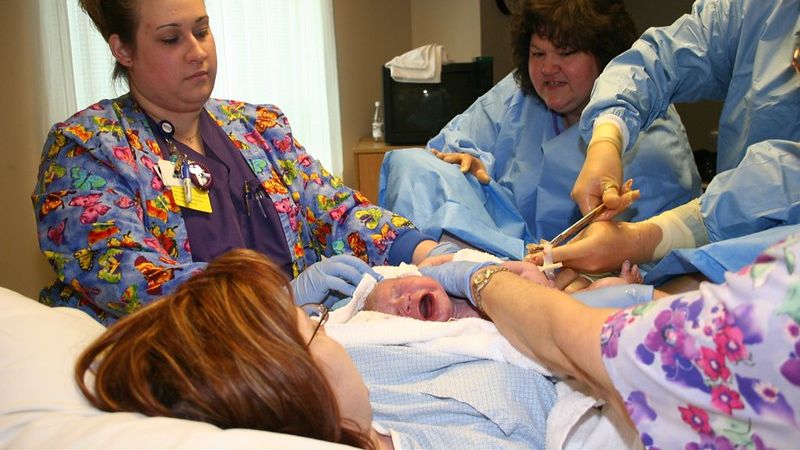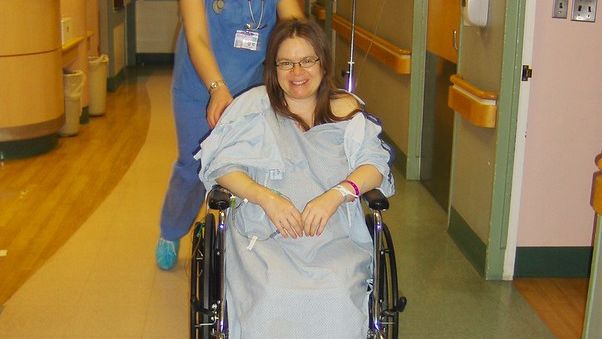Rupture of Membranes

The rupture of fetal membranes (“water breaking”) can occur at any point during pregnancy, but normally occurs during labor and near full dilation.
If rupture occurs prior to labor, this increases the risk of infection if labor does not begin soon after (hours to days). Rupture of membranes prior to 37 weeks creates a high risk for preterm birth.
It is advised pregnant women learn to recognize when their membranes have ruptured, be aware of the signs and symptoms of infection, and call their HCP when they believe rupture has occurred.
HCPs can assess numerous factors to confirm whether rupture has occurred, assess for infection, check the overall health status of both mother and baby, and help determine – depending on assessment – whether induction, delivery, or discharge from the hospital is possible or necessary.
Background
The fetal membranes are formed in layers (the amnion, chorion and decidua) in the second and third trimesters of pregnancy and protect the fetus from trauma and infection; it also provides a cavity in which amniotic fluid accumulates.
Normally, Rupture of Membranes (ROM) occurs when a woman's membranes (water) breaks during labor, toward the end of the dilation stage.
This image contains triggers for: Real Delivery
You control trigger warnings in your account settings.
Prelabor Rupture of Membranes (PROM) is the leaking of amniotic fluid anytime after 37 weeks but before labor starts, which occurs in about 10% of women; labor usually follows soon after – up to 95% of these women will go into labor within 3 days.
Preterm Prelabor Rupture of Membranes (PPROM) is the leaking of amniotic fluid before labor starts and prior to 37 weeks of pregnancy; PPROM occurs in about 2% of women; this usually leads to preterm delivery either immediately or within several weeks.
Mid-trimester PPROM occurs when membranes rupture prior to 28 weeks, and affects approximately 0.4% to 0.7% of all pregnancies.
An amniotomy is the purposeful rupture of membranes by the HCP during labor. An amniotomy can be used to help augment (speed up) the progression of labor, usually after 4 cm of dilation, or at full dilation if the membranes have not yet ruptured.
Cause of Rupture
There are several identified causes that lead to the rupture of membranes. The sac ruptures at its weakest point, which is normally the part of the membranes in direct contact with the internal os of the cervix. The membranes are usually damaged from infection, trauma, or stretch.

An excess accumulation of amniotic fluid (polyhydramnios), or excess fluid plus stretch caused by more than one fetus can over-stretch the membranes and cause them to rupture. However, the membranes can rupture even if the amount of amniotic fluid is small.
Chronic inflammation and infection can result in the production of inflammatory substances (hormones and cytokines) in the uterus, membranes and placenta. Bacteria and viruses can travel up the vagina, into the lower genital tract, and travel further upward through the cervix and into the fetal membranes. Infection weakens the membranes and causes them to rupture.
Further, there is some evidence the cervical mucus/mucus plug in women who experienced preterm labor may not have been effective at keeping bacteria out of the amniotic cavity (read more).
The cervix may also dilate before the onset of labor. When the cervix dilates, the fetal membranes can drop and pass through the cervix, which increases the risk of rupture.
Any type of physical trauma to the abdomen can also result in rupture of the membranes.
Signs and Symptoms
The most common symptom of rupture is a painless gush of clear, watery fluid from the vagina and the possible sound of a small “pop”; however, fluid can also leak slowly, resulting in a gradual but continual trickle. It is also possible, if the total amniotic fluid volume is low, that only a small amount of fluid is released. If the fluid is green, this is due to meconium, or the baby’s bowel movement, and is usually good confirmation of rupture.
If women are unsure if their membranes have ruptured, it is advised they put a pad or panty linter on their underwear to further assess fluid leakage. Note: Amniotic fluid has no odor – while urine does.
Women are also advised to call their HCP immediately if they believe their membranes have ruptured, especially if labor has not begun. The HCP will want to confirm via testing and ultrasound if rupture has occurred, as there are several risks associated with PROM.
Risks and Complications
Several complications are associated with PROM, to include infection, breech, cord prolapse, umbilical cord compression, placental abruption, hemorrhage, and cerebral palsy in the newborn. Unfortunately, it is not possible to assess beforehand which pregnancies are likely to experience complications due to PROM.
However, the earlier the occurrence and the longer the interval between rupture and labor, the more likely complications will occur.

Infection is one of the biggest complications of PROM because it can be life-threatening to both mother and baby if not caught and treated early. Infection risk usually begins climbing within 6 hours of rupture, if labor has not begun.
It is still largely believed the uterine cavity is sterile before rupture. However, newer research indicates this may not be true, and that some level of bacteria is present, even prior to rupture.
Bacteria has been detected in amniotic fluid from pregnancies with complications such as preterm labor, preeclampsia, small for gestational age, and PROM. It has been theorized that if bacteria are already present in amniotic fluid, then complications are likely.
Even if the amniotic cavity is sterile, PROM allows bacteria to get inside, where they can rapidly multiply in the warm and moist environment. The infection can spread in the mother, even after delivery, causing possible pneumonia, sepsis (blood infection), or meningitis in the newborn.
Symptoms of potential infection include fever, odorous and discolored vaginal discharge, increased heart rate in both mother and fetus, and lower abdominal pain – especially when touched. Antibiotics are not given routinely or as a preventative measure to women with PROM, unless signs of infection are present.
Umbilical cord prolapse is also possible with PROM. When the membranes rupture, especially all at once, the cord can be pushed downward through the open cervix, or through the vaginal canal during delivery. In either scenario, the cord can become compressed, cutting off blood and oxygen supply to the baby, resulting in severe and sometimes fatal complications.
The same forceful gush of fluid can also cause the placenta to tear away from the uterine wall, known as placental abruption, causing life-threatening hemorrhage. This is more likely to occur if the cause of the rupture was excessive stretch.
Additionally, when there is a lack of amniotic fluid in the uterine cavity to keep the fetus moving freely, the muscular walls of the uterus can compress the fetus. The fetal bones are not strong enough to withstand this pressure, and deformities of the legs, feet, arms, and hands can occur if this state remains for several weeks.
Regarding PPROM, if membranes rupture prior to 34 weeks of pregnancy, the greatest risk is prematurity, specifically the lungs. If membranes rupture after 34 weeks, the greatest risk is infection, similar to PROM. Therefore, HCPs must balance the risk of infection and prematurity when recommending delivery.
A study published in June 2021 indicated that while gestational age at premature rupture was most strongly correlated with survival, a normal initial amniotic fluid volume may also be a positive indicator of potential neonatal survival.
Assessment and Management
Upon arrival to the woman’s health care facility, an HCP will check the woman’s vital signs, attempt to confirm membrane rupture, determine fetal position and health status, check for contractions, evaluate for signs of infection, bleeding, and discharge, and assess cervical dilation.

When ROM is suspected, an internal pelvic exam using gloved fingers is not used to avoid increasing the risk for infection; some providers will avoid it all together until labor is imminent, while others may use a sterile speculum to confirm and check dilation.
HCPs will use paper strip tests to help determine if amniotic fluid is leaking. Recently, the U.S. Food and Drug Administration warned HCPs about the improper use of these tests. The tests are to be used in conjunction with other signs and symptoms to confirm rupture. The tests should not be the sole confirmatory factor on whether rupture has occurred.
If the woman is not in labor, there are no signs of infection, fetal heart rate and movement are normal, the woman lives near the hospital/birthing center, and is likely to monitor her own health and return when necessary, then she is normally able to return home. Women are advised to call or immediately return if infection is suspected or labor has started; assessments may be performed every 24 to 48 hours by an HCP.
Women may also be offered a choice of induction if ROM is confirmed and labor has not yet begun. Women should be allowed to make an informed choice whether they would like to be induced once ROM is confirmed or wait until labor begins spontaneously while at home. Oxytocin (Pitocin®) is usually the medication of choice, but it is also possible, especially in women with a closed cervix, that a cervical ripening agent may be required first.
If ROM is confirmed but the pregnancy is less than 34 weeks, women are usually admitted to a hospital, given magnesium sulfate to reduce the risk of cerebral palsy, antibiotics to reduce infection, and corticosteroids to increase lung maturity – until the point is reached to where HCPs believe delivery is necessary (and the safest option).
Action
Any woman who suspects her membranes have ruptured at any point during pregnancy should call her HCP, especially if she is less than 37 weeks.
The woman should be prepared to tell her HCP:
What color the fluid is (i.e. clear, green, yellow) or if the fluid has an odor
When she noticed the fluid and how much fluid she thinks has leaked
Contraction status
If there is a change in the baby's movements
Group B strep test result (if positive)
If the woman is having a planned cesarean section or has a history of preterm or quick labors
Women should also consider:
Drinking plenty of fluids
Avoiding putting anything in the vagina
Geting some rest (prior to labor beginning)
Monitoring their babies' movements
Checking their temperature every four hours; an HCP will need to be called if the temperature goes above 99.6 °F/37.6 °C.
Showering is not associated with an increase in infection, but evidence regarding bathing indicates caution may be necessary.
However, regardless of the above, women need to follow the specific instructions given to them by their HCP if their membranes rupture. Women should ask their HCP early in the second trimester what the HCP would recommend in the event of PROM or ROM so they can be prepared.
Resources
Prelabor Rupture of Membranes (American College of Obstetricians and Gynecologists)
Care of Women Presenting with Suspected Preterm Prelabour Rupture of Membranes from 24+0 Weeks of Gestation (Royal College of Obstetricians and Gynaecologists)